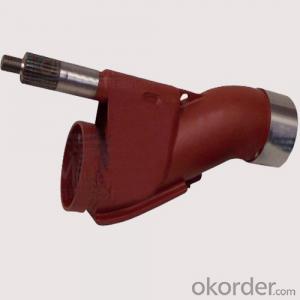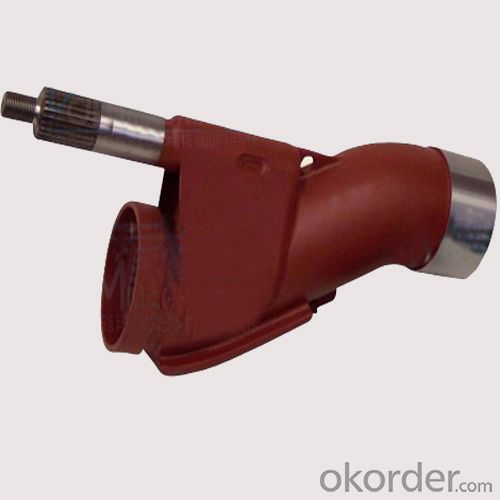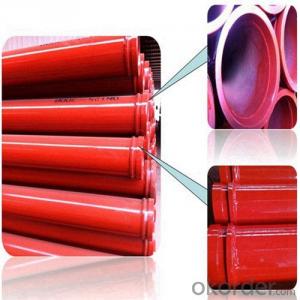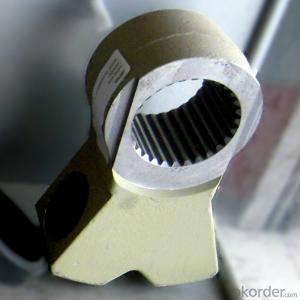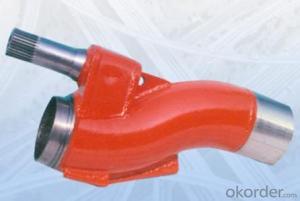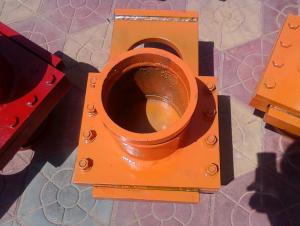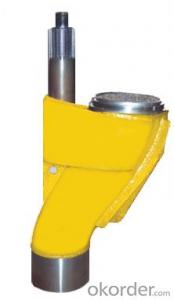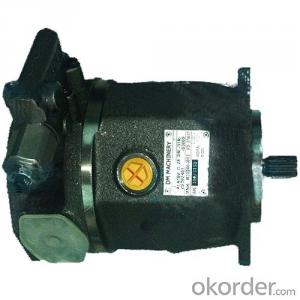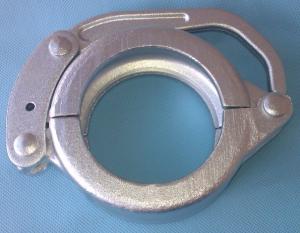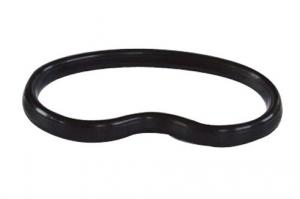Concrete Pumps Spare Parts S Valve S2018N
- Loading Port:
- Tianjin
- Payment Terms:
- TT OR LC
- Min Order Qty:
- 1 pc
- Supply Capability:
- 1000 pc/month
OKorder Service Pledge
OKorder Financial Service
You Might Also Like
Product Description:
The PM Z Type Concrete Pumps Spare Parts S Valve S2018N normally made by steel material No.ST52, 20#, 37MN5, Q235B according to customer’s requests, and also package in bundles or nude packing directly put into container.
Scope of Application of the pipes
The PM Z Type Concrete Pumps Spare Parts S Valve S2018N is a concrete vavle for combined use with other concrete pipelines in concrete placement operations. It can be widely used in the construction of various types of concrete structures like industrial and civil buildings, bridges, roads, and other types of infrastructure.
This pipes can only be used for concrete pumps and truck pumps, but not in any other machines, like crane, loader and other road machinery.
Product Advantages:
OKorder's Concrete Pumps Spare Parts S Valve S2018N Channels are durable, strong, and safety.
Main Product Features:
· Premium quality
· Prompt delivery & seaworthy packing (5-10 days)
Reliable performance
Easy to weld
High safety.
· Professional Service
· Competitive pricing
Measuring of wall thickness from the outside
Low purchase cost
Specifications:
CNBM No. | 2201808 |
Original No. | 251013 008 |
Description | S Valve |
Remark | S2018N |
FAQ:
Q1: How long about delivery time Concrete Pumps Spare Parts S Valve S2018N ?
A1: Normally we keep the raw materials for old customers and sometime we also keep stock products to make sure delivery time in any emergency cases.
Q2: How do we guarantee the quality of our Concrete Pumps Spare Parts S Valve S2018N ?
A2: We have established an advanced quality management system which conducts strict quality tests at every step, from raw materials to the final product. At the same time, we provide extensive follow-up service assurances as required.
Q3: How soon can we receive the product after purchase?
A3: Within three days of placing an order, we will book the vessel for goods. The specific shipping date is dependent upon international and government factors, but is typically 7 to 30 workdays.
Q4: If we can produce some pipes according to customers request?
A4: Yes, we can produce S Vavle according to the difference country situations to make it suitable to the market and customers. We have very professional technical team to make the design.
Q5: How to make a quick resolution for after service?
A5: OKorder and our manufacture both have overseas branches all-around of world.
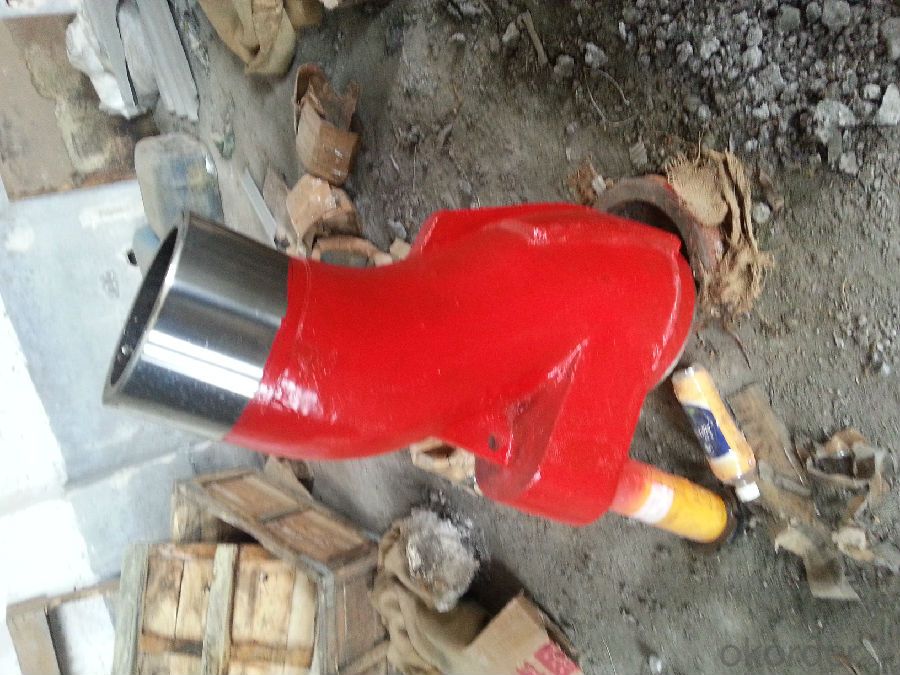
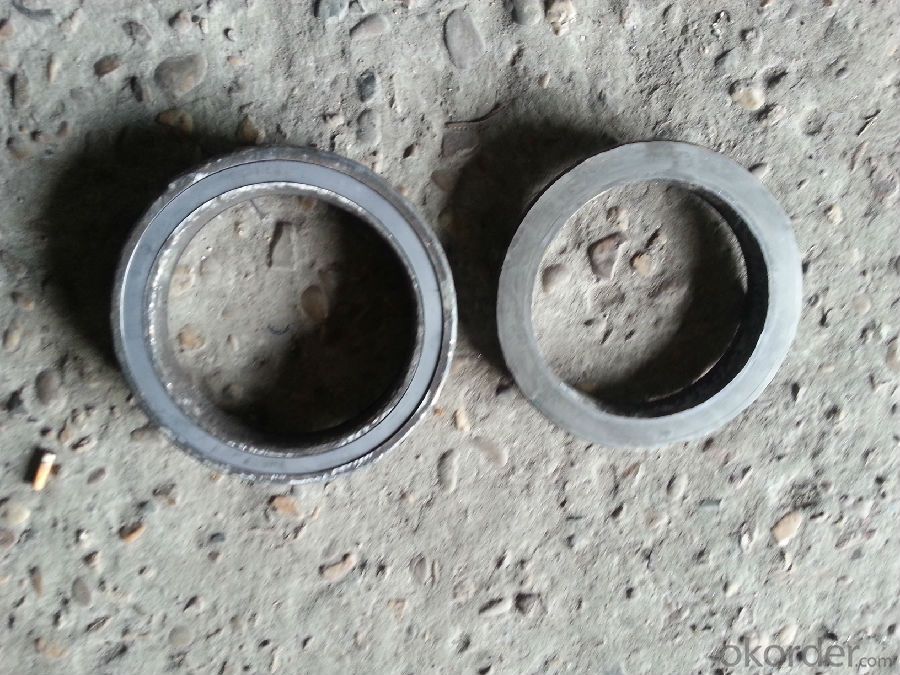

- Q: What are the potential risks of using non-standard or modified hydraulic components in concrete pump spare parts?
- There are several potential risks associated with using non-standard or modified hydraulic components in concrete pump spare parts. Firstly, these components may not have undergone the same rigorous testing and quality control as the original equipment manufacturer (OEM) parts. As a result, their performance and durability may be compromised, which can lead to potential failures or malfunctions. This, in turn, can cause accidents, injuries, or damage to the equipment or surrounding structures. Secondly, the use of non-standard or modified components may void the warranty of the concrete pump and its spare parts. Typically, manufacturers offer warranties to ensure the reliability and safety of their products. However, by using non-standard components, the warranty may become null and void. Consequently, the user will be responsible for any repairs or replacements needed due to issues arising from these non-standard parts. Another risk is the potential compatibility issues that may arise when using non-standard or modified components. Hydraulic systems rely on precise engineering and compatibility between various components to function optimally. Non-standard or modified parts may not fit properly or may have different specifications, resulting in leaks, pressure imbalances, or reduced overall performance. Furthermore, the use of non-standard or modified components can impact the overall efficiency and productivity of the concrete pump. OEM parts are specifically designed to work seamlessly with the rest of the system, ensuring smooth operation and maximum output. However, by using non-standard parts, the performance of the pump may be compromised, leading to increased downtime, decreased productivity, and higher maintenance costs. Lastly, the use of non-standard or modified components can also have legal and regulatory implications. Certain jurisdictions may have regulations or standards in place that require the use of OEM or certified parts for specific equipment, including concrete pumps. Failure to comply with these regulations can result in fines, penalties, or legal liabilities in the event of accidents or failures. In conclusion, the potential risks associated with using non-standard or modified hydraulic components in concrete pump spare parts include compromised performance and durability, warranty voidance, compatibility issues, reduced efficiency, and legal and regulatory implications. It is always advisable to use OEM or certified spare parts to ensure the safety, reliability, and optimal performance of the equipment.
- Q: What are the signs of a clogged or damaged hydraulic filter?
- There are several signs that may indicate a clogged or damaged hydraulic filter. One of the most common signs is a decrease in hydraulic system performance. If you notice a decrease in the speed or power of your hydraulic equipment, it could be a result of a clogged filter restricting the flow of hydraulic fluid. Another sign is increased heat in the hydraulic system. A clogged or damaged filter can cause the system to overheat as it struggles to maintain proper fluid flow and pressure. Additionally, you may notice unusual noises coming from the hydraulic system. A clogged filter can lead to air being trapped in the system, causing it to make strange noises such as whining or grinding. Furthermore, if you see dirty or discolored hydraulic fluid, it could indicate a clogged or damaged filter. The filter is designed to remove dirt and contaminants from the fluid, so if it is unable to do so effectively, the fluid will become dirty and discolored. Lastly, if you experience frequent or recurring issues with the hydraulic system, it could be a sign of a clogged or damaged filter. The filter plays a crucial role in maintaining the overall health of the hydraulic system, so if it is not functioning properly, it can lead to other problems such as pump failure or valve blockages. It is important to regularly inspect and replace hydraulic filters to ensure the proper functioning and longevity of your hydraulic system.
- Q: Can concrete pump spare parts be used interchangeably between different pump brands or models?
- No, concrete pump spare parts cannot be used interchangeably between different pump brands or models. Each brand and model of concrete pump has its own unique design and specifications, requiring specific spare parts that are compatible with that particular pump. Using interchangeable parts can lead to ineffective functioning and potential damages to the pump. It is crucial to use the correct spare parts recommended by the manufacturer to ensure optimal performance and longevity of the pump.
- Q: What is the role of a concrete pump hopper agitator blade?
- The role of a concrete pump hopper agitator blade is to mix and agitate the concrete mixture in the hopper, ensuring a consistent and homogeneous mixture. This helps to prevent the concrete from settling or becoming too thick, allowing for a smoother and more efficient pumping process.
- Q: What is the role of a concrete pump spectacle plate?
- The role of a concrete pump spectacle plate is to provide support and stability to the concrete pump's boom. It acts as a mounting base for the pipeline, allowing the pump to accurately and efficiently deliver concrete to the desired location.
- Q: What are the different types of concrete pump rubber hoses?
- In the market, you can find a variety of concrete pump rubber hoses. These hoses come in different types to cater to specific needs. The first type is the Steel Wire Reinforced Hose, which is the most commonly used. It is built with multiple layers of steel wire to provide maximum strength and durability. This type of hose is suitable for high-pressure applications and can handle the heavy pumping of concrete effortlessly. Another type is the Textile Reinforced Hose, which is reinforced with multiple layers of textile fabric like nylon or polyester. These hoses are lighter in weight compared to the steel wire reinforced ones, making them easier to handle and maneuver. They are suitable for medium-pressure applications and are commonly used in smaller concrete pumps. Then there is the Fabric Hose, which is made from a single layer of fabric like nylon or polyester. These hoses are lightweight and flexible, making them easy to handle and transport. Fabric hoses are suitable for low-pressure applications and are commonly used in small-scale construction projects. Composite Hoses are made from a combination of different materials such as rubber and plastic. These hoses are lightweight and highly flexible, which makes them ideal for applications where maneuverability is crucial. They are commonly used in smaller concrete pumps and can handle both low and medium pressure. Lastly, there are Flanged Hoses, which have flanges attached at both ends. These flanges are used to connect the hose to the pump and the nozzle, providing a secure connection and preventing any leaks or disconnections during the pumping process. Flanged hoses are commonly used in high-pressure applications and are suitable for large-scale construction projects. In conclusion, the choice of concrete pump rubber hose depends on specific project requirements. Factors such as pressure, size, and type of concrete being pumped should be considered to ensure efficient and safe concrete pumping operations.
- Q: How do I properly maintain and replace hydraulic filters in concrete pump spare parts?
- To ensure your equipment's longevity and efficiency, it is crucial to properly maintain and replace hydraulic filters in concrete pump spare parts. Here are some guidelines to follow: 1. Familiarize yourself with the manufacturer's recommendations: Understand the maintenance and replacement guidelines provided by the manufacturer. These instructions may vary based on the specific pump model and filter type. 2. Regularly inspect the filters: Conduct regular inspections to identify any signs of damage, clogging, or excessive wear in the hydraulic filters. Look out for dirt, debris, or other contaminants that may hinder their performance. Address any issues promptly. 3. Establish a maintenance schedule: Implement a regular maintenance schedule for the hydraulic filters. This should include regular inspections, cleaning, and replacement intervals. Adhering to a schedule will prevent unexpected breakdowns and keep the concrete pump running smoothly. 4. Clean the filters: If the hydraulic filters can be cleaned and reused, ensure to follow the proper cleaning procedure. This typically involves removing the filter, washing it with a suitable cleaning solution, and allowing it to dry thoroughly before reinstalling. Take care not to damage the filter during the cleaning process. 5. Replace as necessary: Over time, hydraulic filters become less effective at filtering out contaminants. It is important to replace them according to the manufacturer's recommended intervals or sooner if they appear excessively dirty or damaged. Always use genuine spare parts to ensure compatibility and optimal performance. 6. Install correctly: When replacing hydraulic filters, ensure they are installed correctly and securely. Pay attention to any seals or gaskets that may need replacement as well. Improper installation can lead to leaks or reduced filtration efficiency. 7. Monitor performance: After replacing the hydraulic filters, closely monitor the pump's performance. Watch for changes in pressure, flow rate, or unusual noises. If any abnormalities are observed, it may indicate a problem with the filter or other components, requiring further investigation. By following these steps, you can effectively maintain and replace hydraulic filters in your concrete pump spare parts, ensuring optimal performance and extending the equipment's lifespan.
- Q: How do I properly maintain and replace rubber pistons in concrete pump spare parts?
- To guarantee efficient pump operation and extend equipment lifespan, it is imperative to maintain and replace rubber pistons in concrete pump spare parts. Below are guidelines for proper maintenance and replacement: 1. Regularly Inspect: Regularly examine the rubber pistons to detect any wear or damage. Look for visible signs of deterioration such as cracks, tears, or other forms of degradation. 2. Thorough Cleaning: Prior to replacing the rubber pistons, thoroughly cleanse the surrounding area. Remove any dirt, debris, or concrete residue that may be present. This will prevent contamination and ensure a proper fit for the new pistons. 3. Adequate Lubrication: Apply a suitable lubricant to the rubber pistons to guarantee smooth operation and reduce friction. This will prolong the pistons' lifespan and prevent premature wear. 4. Proper Installation: When replacing the rubber pistons, ensure correct installation in accordance with the manufacturer's instructions. Utilize appropriate tools and techniques to avoid damaging the pistons or other pump components. 5. High-Quality Replacement Parts: Always opt for reputable suppliers and utilize high-quality replacement rubber pistons. Inferior quality pistons may not perform optimally and could result in frequent replacements or pump damage. 6. Regular Maintenance: Establish a regular maintenance schedule for your concrete pump, including the rubber pistons. This may involve cleaning, lubrication, and inspection of the pistons to identify potential wear or damage before they become major issues. 7. Training and Expertise: Ensure that the individual responsible for maintaining and replacing the rubber pistons possesses the necessary training and expertise. This will ensure proper execution of the task and minimize the risk of pump damage or personnel injury. By adhering to these guidelines, you can effectively maintain and replace rubber pistons in concrete pump spare parts, thereby ensuring optimal equipment performance and longevity.
- Q: How often should hydraulic cylinders be inspected or replaced in a concrete pump?
- Hydraulic cylinders in a concrete pump should be inspected regularly, ideally every 500 hours of operation or at least once a year, whichever comes first. However, it is important to note that the frequency of inspections may vary depending on the specific conditions and usage of the concrete pump. During inspections, qualified technicians should thoroughly examine the hydraulic cylinders for any signs of wear, damage, or leaks. They should also check the alignment, piston rods, seals, and other components to ensure proper functioning. If any issues are found, such as excessive wear or leaks, it is recommended to replace the hydraulic cylinders promptly to prevent further damage and maintain optimal performance. Regular inspections and timely replacements of hydraulic cylinders are crucial for ensuring the safety, efficiency, and longevity of a concrete pump. Neglecting proper maintenance can lead to costly repairs, decreased productivity, and even accidents. Therefore, it is essential to follow manufacturer's guidelines and consult with professionals to determine the appropriate inspection and replacement intervals for hydraulic cylinders in a concrete pump.
- Q: What are the different types of concrete pump hoses?
- There are generally two types of concrete pump hoses: steel-reinforced hoses and fabric-reinforced hoses. Steel-reinforced hoses are stronger and more durable, suitable for high-pressure applications and long-distance pumping. Fabric-reinforced hoses are lightweight and flexible, ideal for smaller projects and shorter pumping distances.
Send your message to us
Concrete Pumps Spare Parts S Valve S2018N
- Loading Port:
- Tianjin
- Payment Terms:
- TT OR LC
- Min Order Qty:
- 1 pc
- Supply Capability:
- 1000 pc/month
OKorder Service Pledge
OKorder Financial Service
Similar products
Hot products
Hot Searches
Related keywords
